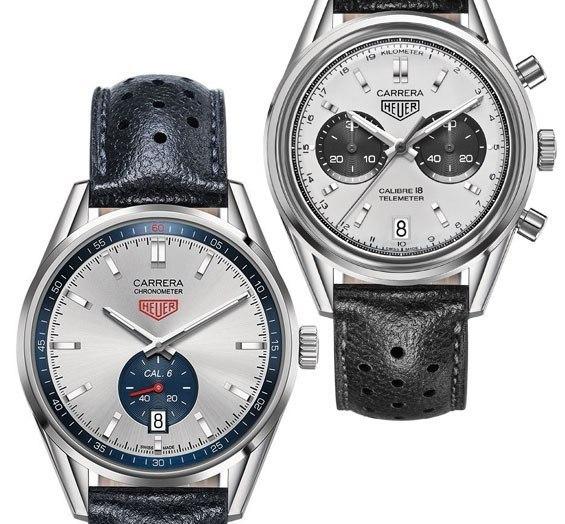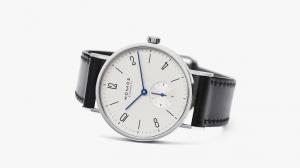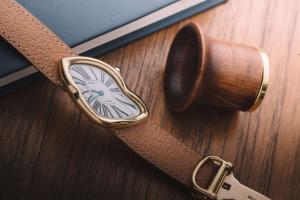Carrera: TAG Heuer’s Iconic Chronograph Watch

The relationship between watches and motorsports dates back many decades. Just take a look at the plethora of options for chronograph watches. There’s the Rolex Daytona, the Tissot T-touch, and of course, the TAG Heuer Carrera.
The Carrera is one of the most iconic, if not the most iconic, models of the brand. And it all started when Jack Heuer attended a famous motorsport event. Read the whole story below.

What’s in a Name?
In March of 1962, TAG Heuer served as the Sebring Sportscar race’s official timekeeper. Jack Heuer, who had just succeeded his uncle in running the company, went to the event. The free pass served as an appreciation token for lending stopwatches.
Being a fan of Ferrari, Jack went to the Ferrari pit where the racecar drivers were stationed. He struck up a conversation with the parents of the young Rodriguez brothers. The brothers, Ricardo and Pedro, were the team’s hotshot drivers at the time.
The parents expressed their fear for their sons’ safety. To give you an idea, the race lasted for at least 12 hours and cars sped at an average of 117mph. However, as a consolation, the couple were still thankful that their children did not get the chance to participate in the Carrera Panamericana — a far more dangerous race — because they were still underaged when the said event was cancelled.
Long after the conversation was over, the name Carrera stayed with Jack. Coincidentally, it means “race” in Spanish which Heuer watches are known for. Later that year, he registered the name for exclusive rights and the rest, as they say, is history.

Carrera Panamericana: The Deadliest Race in History
The Carrera Panamericana sounds like the ultimate dream for racecar drivers because it was a border-to-border racing event on open roads in Mexico. It was very similar to the Targa Florio in Italy.
However, the race was short-lived. No matter how exciting it was, the Mexican government decided to cancel the race for good due to safety and financial concerns. And to give you an idea of how dangerous it was, 27 people had died during its five-year run. This gives it the highest mortality rate in the history of motorsports.
Don’t get us wrong. Jack did not name it Carrera because of its gruesome background. He chose the name because he thought it was a word that people could easily remember and pronounce. Since then, the brand made it a habit to name their chronographs after race events. Just take a look at Monaco and the Formula 1 collections.
The Making of an Icon
It is important to note that back then, Heuer was not as big as it is today. That is why many of its watch parts were not manufactured in-house. To put it another way, they sourced different parts from suppliers and assembled them into a watch. The Carrera’s dial, for example, was made by Singer while its movement was made by Valjoux.
This isn’t something to be wary of as it was common in Swiss watchmaking back in the day. In fact, the Rolex Daytona used the same dial made by Singer. That’s why if you would observe, they share the same exact hour markers, milled registers, and numerals on the milled registers.
Legibility is a Top Priority
A chronograph watch is generally cluttered. They’re supposed to have all these subdials for the timers and stopwatches. However, Jack Heuer wanted to keep the Carrera’s dial legible. And being educated on product design, he made sure that the dial of the Carrera stayed free from clutter.
If it were up to Jack, he wouldn’t even put tracks on the dial at all. However, it was essential to the targeted market so he had very little choice but to add those.
THE DIFFERENT VERSIONS OF THE CARRERA
Heuer’s precious chronograph watch stood the test of time. And while the product was excellent the first time around, it was inevitable to give it a few upgrades. Here are the different versions of the Carrera throughout the years — from its conception to its downfall and up to its epic comeback.

The First Version
Finally, in 1963, Heuer released the first version of the Carrera with reference number 2447. Following the principles that Jack learned from the Swiss Federal Institute of Technology in Zurich, they kept the dial of the watch clean and simple.
The watch came in a 36mm case. By today’s standards, it would be considered small and difficult to read — which is ironic since Heuer wanted something legible. However, during those years, it was considered of average size.
Even with three subdials, the dial looked uncluttered as they removed all decorative elements and kept only what’s essential. This signature look of the Carrera paved its way to immediate success. Thus, they didn’t waste time releasing other versions of it.

Two-Toned Carreras
While the first iteration came in a uniform colour, it wasn’t long before they released two-tone versions. One of these colourways is known as the Panda, where the dial is white and the subdials are black. If you look carefully, it looks a lot like the cute animal that it was named after.
The other one is the Reverse Panda. Based on its name, it is the exact opposite of the Panda. Instead of white, it has a black dial. Its subdials, on the other hand, are all black. According to designers and users, the contrasting hues of the subdials and dials heightened the watch’s legibility.

The Carrera at its Peak
It is no denying that the ’70s was considered as the watch’s Golden Era. Before this revamped version, Carreras only came in hand-wound movements. Imagine having to manually wind it every now and then! Thankfully, Heuer decided to release one of the world’s first automatic chronographs.
It was also during this era when Heuer started producing colourful and barrel-shaped watches. Apart from that, they earned enough traction to collaborate with Ferrari and other notable racecar drivers.
From Heuer to TAG Heuer
As the old saying goes, “even the best fall down sometimes” and the Carrera was no exception. During the Quartz Crisis, the iconic chronograph almost met its demise. The model was temporarily discontinued in 1984.
With no other choice left, Jack Heuer was forced to sell his company to Techniques d’Avant Garde (TAG). This is the reason why Heuer is now known as TAG Heuer. After being sold to TAG, the brand’s collection went a slightly different route. While they stopped the production of the Carrera, they didn’t wander far away from its connection with motorsports. In fact, they introduced a Formula 1 collection. In effect, it only strengthened the brand’s roots in car racing.
An Epic Comeback
It seems that the world couldn’t get enough of the Carrera. So, in 1996, the company decided to revive it. TAG Heuer reintroduced their chronograph that looks a lot like the first one. This time, it was equipped with hand-wound Lemania movements or automatic ETA chronographs. Since then, the Carrera line continues to improve and grow.
MODERN VERSIONS OF THE TAG HEUER CARRERA
As stated above, the Carrera has seen many facelifts and upgrades since its comeback. Here are some of the modern versions of the chronograph that are available.
TAG Heuer Carrera Skeleton
For the ultimate watch geek, you should check out the TAG Heuer Carrera Skeleton. Its open-body format will allow you to admire and observe all the moving parts of the timepiece.
TAG Heuer Carrera Quartz
If you don’t mind owning a quartz watch, the TAG Heuer Carrera Quartz is a good alternative. Apart from being cheaper, you also do not have to wind it every now and then.
If you’re still wary of quartz watches, you can read our article on why it shouldn’t be a dealbreaker.
TAG Heuer Carrera Ladies
The Carrera isn’t just for men. If you find that the other models sit a bit large on your wrist, you should definitely consider the Ladies’ version. At only 28mm, this size will fit small wrists perfectly.
TAG Heuer Carrera Calibre
The Calibre is the modern alternative to the vintage Carreras. It sports the same minimalist dial as well as the subtly recessed subdials.
However, instead of silver baton markers, this version features rose gold Arabic numerals to tell the time. Despite the deviation, the look of this watch remains uncluttered and easy to read.
TIPS ON HUNTING FOR A VINTAGE CARRERA
While there are more high-tech and modern upgrades to the Carrera, the vintage versions still get some love. For several reasons, watch collectors love going after the earlier iterations of the Carrera. It may be because of nostalgia or they prefer the vintage aesthetic of the older models. If you’re out on a hunt, here are a few pointers to keep in mind.
Serial Number
As for any watch, one thing that tells the most about a specific model is the serial number. If you’re looking for the earliest versions of the Carrera, you should be looking at a number that starts at 54XXX.

The SWISS Marker Should NOT Have a “T”
Have you ever noticed the “T SWISS T” printed on the lower part of your Swiss watch’s dial? Apparently, the letter “T” means that your watch contains tritium-activated deposits.
If you’re after the early versions of the Carrera, this is one green flag. A 1964 catalogue of Heuer showed all Carrera watches with only the “SWISS” marking on them.
However, we are not sure whether it means the early models didn’t have tritium or if the marking system for the tritium still wasn’t uniform during that time. Your guess is as good as mine.
Check How Thin the Hands Are
It seems like narrow hour and minute hands were the norm before. While we do not have the exact measurement, the hands of the earlier Carreras should be similar to the hands of Mark 1 Daytonas.

Who Signed the Movement?
Although it takes more effort to check than the others, this indicator is one of the most reliable. Ask your trusted watchmaker to pry open your watch’s case. The movement should be signed “Ed. Heuer”. Only Heuer watches made before 1964 have this signature, as those that were made after have the “Heuer-Leonidas” sign.
The Crown Should Be Blank
Take a moment to observe your watch before you wind it. If the crown does not show the Heuer shield on it, it is a sign that it’s vintage. As an added info, the crowns from earlier Carreras were slightly larger than the newer models.
WRAPPING UP
The current lineup of the Carrera collection taps a wider market and the examples shown above are proof of that. Meanwhile, its vintage editions are a great symbol of the brand’s connection with motorsports. Love them or hate them, there is no denying that the Carrera is one of the most respected wristwatches to date. Its influence on chronograph watches and TAG Heuer as a brand will forever be remembered by watch enthusiasts.
Interested in watches with a peculiar history? Read about how a car crash inspired the launch of the Cartier Crash.


